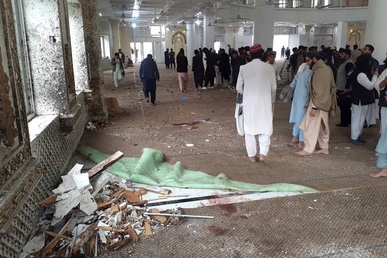By Khalid Khan
Darul Uloom Haqqania in Akora Khattak has once again become the focus of headlines, news bulletins, and analytical discussions. However, this renewed attention is not due to an intellectual debate or ideological discourse but rather a tragic incident that has cast a shadow of mourning over the entire country.
On Friday, February 28, 2025, a suicide attack within the seminary’s premises claimed the lives of its key figure, Maulana Hamid-ul-Haq, along with six worshippers. This horrifying event is yet another addition to the rising tide of terrorism in Pakistan, raising pressing questions about the country’s security landscape.
Darul Uloom Haqqania is one of Pakistan’s oldest and most influential seminaries, often referred to as “Deoband Sani” (the second Deoband). It was established in 1947 by Maulana Abdul Haq, the grandfather of Maulana Hamid-ul-Haq, and over time, it became a hub for religious, militant, and political activities. During the Soviet-Afghan war, the seminary played a pivotal role in training and nurturing jihadist leadership. While the first fatwa against the Soviets was issued by Maulana Mufti Mahmood and the initial resistance movement was organized in Waziristan under the leadership of Maulana Fazlur Rehman, it was Maulana Sami-ul-Haq, the father of Maulana Hamid-ul-Haq, who became the central figure in mobilizing jihadist efforts. Over time, the paths of Maulana Fazlur Rehman and Maulana Sami-ul-Haq diverged, as powerful forces within the Afghan resistance favored the latter. Many prominent Mujahideen leaders, including Jalaluddin Haqqani, Younus Khalis, and Muhammad Nabi, were graduates of Darul Uloom Haqqania, cementing its reputation as an institution deeply tied to the Afghan conflict and, later, the Taliban movement.
Following the attack, a war of narratives has erupted between Tehrik-e-Taliban Pakistan (TTP) and Jamaat-ul-Ahrar. The TTP swiftly condemned the attack, accusing Jamaat-ul-Ahrar of desecrating a sacred institution to further its nefarious agenda. In contrast, Jamaat-ul-Ahrar dismissed the allegations, suggesting that the attack could be a result of internal strife within the TTP itself. Analysts believe this clash reflects growing divisions among Taliban factions, where differences in leadership and ideology are escalating into open conflict.
Initial investigations indicate that the attacker was an Afghan national, reinforcing concerns that Afghan soil is once again being used as a launchpad for terrorist activities against Pakistan. The country has repeatedly voiced its apprehensions regarding the presence of militant groups in Afghanistan, and this incident has further intensified those fears. Pakistani authorities maintain that any elements operating from Afghan territory against Pakistan’s security will be dealt with firmly. Some sources reference intelligence reports suggesting that terror networks are using Afghanistan as a safe haven, raising serious questions about cross-border security dynamics.

This attack comes at a time when Pakistan is already grappling with a fresh wave of terrorism, particularly in Khyber Pakhtunkhwa and Balochistan, where militant activities have seen a sharp uptick. Since the 2024 assassination attempt on a senior Haqqani Network leader in Kabul, regional tensions have only deepened, with repercussions spilling over into Pakistan. Some observers believe that such attacks are part of a broader effort to disrupt Pakistan’s relationship with the Afghan Taliban. They argue that destabilizing Pakistan could be part of a larger geopolitical agenda involving international players.
The future of Darul Uloom Haqqania also hangs in the balance following this attack. After the assassination of Maulana Sami-ul-Haq, his son Maulana Hamid-ul-Haq took over the seminary’s leadership. Now, with his tragic death, the institution faces an uncertain road ahead. Will it retain its historical influence, or will internal and external pressures lead to a transformation in its role? Experts speculate that any shift in the seminary’s direction could have far-reaching consequences, particularly for both Afghan and Pakistani Taliban factions.
For Pakistan, this incident serves as yet another test in its long battle against terrorism. The country has endured years of conflict, but this latest attack underscores the need for a renewed strategy—one that not only targets domestic militant networks but also addresses the evolving threats emerging from Afghanistan. Security agencies are already considering stricter measures, including enhanced protection of religious institutions, to prevent similar tragedies in the future.
This attack is not just an isolated act of violence; it is part of a much larger and more complex scenario where extremist factions, global powers, and regional politics are all entangled. Pakistan must navigate this crisis with a clear-eyed approach, recognizing that this is not merely a tragic event but a dire warning. Is this attack a prelude to deeper factional fighting within the Taliban, or does it signal the beginning of a new wave of terrorism against Pakistan? Will Afghanistan’s current leadership alter its stance on cross-border militancy, or will Pakistan face even greater security challenges in the days to come? These are the critical questions whose answers will unfold in the near future.
